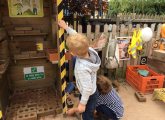Exploring shapes is the perfect introduction to mathematical learning, says Barbara Isaacs…
Long before children are ready for formal instruction in arithmetic and the operations of addition, subtraction, multiplication and division we must introduce them to shapes, to matching and pairing, sorting and grouping, as well as sharing out. These skills and activities prepare children for later mathematical operations and for later systematic study of geometry.
While the mere mention of ‘geometry’ will cause anxiety for many, young and old, very young children have no qualms in exploring 3D shapes almost from birth. Think of the rattles, fluffy cubes and squeezable balls they’re given to welcome them into the world, or the diverse shapes they play with as they lie under the ‘baby gym’. Then, as they become mobile, toddlers begin to build a wide range of structures reflecting their interests and experiences as they use construction toys. In most nurseries the unit blocks that originated with Froebel’s gifts are a much-loved resource because they give children opportunities to create and represent towers, houses, castles and airports, and roads on which to wheel their favourite cars. Whilst this play takes place, they compare and absorb the relationships of the various prisms that form the foundation of what the unit blocks offer.
Playing with blocks also affords children opportunities to explore symmetry, learn about the relationships between the blocks and come to appreciate empty spaces and the light that shines through their structures – the essential principles of architecture as we know it today. Many young children’s creations demonstrate a real appreciation of form.
Montessori nurseries have a large collection of solid and flat shapes to be explored by the children in what is known as the ‘sensorial’ area. They comprise a set of 10 graded-in-size pink cubes, brown prisms and red rods, as well as a range of cylinders organised by colour according to diminishing circumference and height. These serve as interesting learning tools in their own right, helping children understand the relationships in size and sequence. But it’s when they are combined and used in conjunction with the unit blocks that we often see their value in supporting children’s learning. They come to be used as symbols to represent the child’s thinking whilst constructing a castle, tower or the Taj Mahal, offering us a real insight into their understanding of the materials and their creative abilities. We also combine the solid shapes with the flat shapes to highlight the structure of the solids and as a preparation for learning names such as ‘square-based pyramid’, ‘triangular-based prism’, ‘hemisphere cone’ or ‘ovoid’.
Children are exposed to a wide range of flat shapes with which to tessellate or draw around to make patterns – at first commonly encountered examples, but also more unusual shapes such as curvilinear triangle, oval and ellipse and the quatrefoil. As children explore these we introduce their names, which soon become part and parcel of their vocabulary. I believe this exploration and spontaneous play, combined with the use of proper names, gives young children a solid foundation in geometry that will serve them well in later life.
Barbara Isaacs is the academic director of Montessori Centre International.

STEAM learning – Teaching it in Early Years
Editors picks

Speech and language support – Resources for Early Years
Editors picks

Exploring the World in Montessori Early Years Settings
Editors picks
